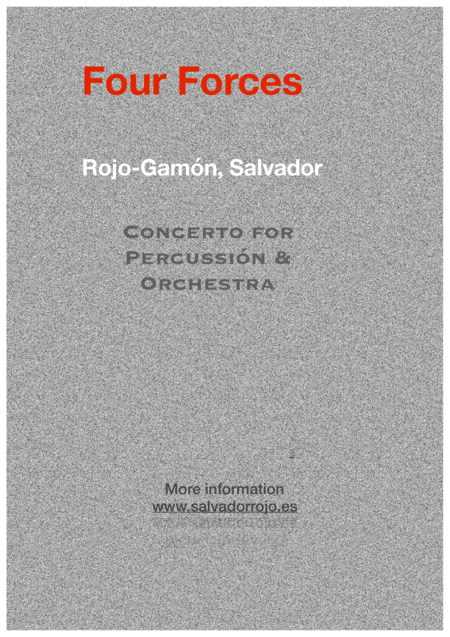Percussion Ensemble - Level 5 - Digital Download SKU: A0.962406 Composed by Salvador Rojo Gamón. Concert,Contemporary,Instructional,Standards. Score and parts. 173 pages. Salvador Rojo-Gamon #5801913. Published by Salvador Rojo-Gamon (A0.962406). Four ForcesReviewsScherzohttps://scherzo.es/badajoz-vanguardias-lugarenas/Periodico Extremadurahttps://www.elperiodicoextremadura.com/noticias/badajoz/fuerzas_1214372.html NotesThis work was commissioned by Extremadura Orchestra for Percussion and Chamber orchestra.It has two movements. The first one has been done for mallets and the second one was built on a base of a drums work (GEA).The duration of those movements is 26 minutes, being around 11 minutes the first and 15 minutes the second one.The chamber music is formed by:Woodwind quintet (Flute, Oboe, Clarinet, Horn & Bassoon)Brasswind quintet (Trumpet 1, Trumpet 2, Horn, Trombone & Tuba)Strings orchestraThree firsts violinsThree seconds violinsThree violasTwo cellosFor the second movement is high recommendable to enlarge the strings, a good number of musician could be doubling.I. Strong ForcesThe work is inspired by the four fundamental forces of nature. These forces explain any phenomena which can be produced in the universe.Throughout all composition, it is latent the mathematic construction based in the series Fibonacci. In the first of the movements, Fibonacci's series is present in the notes' sequence that forms the series of 16 sounds and it is going to be present throughout the whole work. This series is taking form along the movement and it is getting melody and harmony.Although it is far away from the sonata form, as we know it in its period of highest glory, it takes elements of it and updates to our days. In this movement, we can find sonata form elements as the exposition, development, transitions or coda.The central part of the first movement becomes in the slow movement, being more intimate and lyrical, free of the serials ties although it uses resources before cited -now called common practice-.The movement finish with a short re-exposition that concludes with the virtuosic of the soloist doubling the series and adding more tension until conforming the series in its full whole.II. Weak ForcesIt is the most tribal of both movements. Its structure is more complex and in it, we also can find clear reminiscences to the sonata form.We can divide the movement into two big blocks. The first one is formed for the introduction and sections one and two.IntroducciónIt is based in one ostinato of three notes where the accent is changing provoking unsymmetric, this ostinato represents the nucleus of our existence. The piccolo and the trombone introduce us to the human element representing the two elements that form the development of the whole movement.The two elements of thematics are taken from the series, the first one is easily recognizable because it appears in his primary form.First section & cadenzaIn this movement, the rhythm, the melody, and the harmony are based on the sequence of Fibonacci. As the theme ostinato of the soloist as the melody is formed under the rhythm of 1, 2, 3 and 5. This section leads us to the second section with a clear mode of cadence. In the cadenza, the elements of the rhythm are varied freely with an accompaniment of the Spring Drum.DevelopmentIt is formed by two Rondo sub-sections in which the solo part has been created through the mirror technique.Both sections have the next form:Intro-A-B-A-B-(B(minor)+A)Intro-A-B-A-B-(B(major)+A)First section & CodaThe movement ends with the repetition of the first section and the final code.
